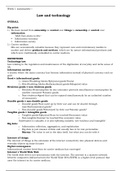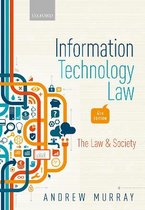Week 1 summaries—
Law and technology
OVERALL
Big point:
1.) We have moved from ownership or control over things to ownership or control over
information
‘Shift from atoms to bits’
Information economy
Information society
2.) Carrier medium
Bits are economically valuable because they represent new and revolutionary models to
market and deliver products and services, which are by nature informational products and
which were traditionally embedded in carrier medium.
DEFINITIONS
Technology law:
Law relating to the regulation and maintenance of the digitization of everyday and niche areas of
life
Information society:
A society where the main currency has become information instead of physical currency such as
gold
Good v informational goods
1.) Atomsbuilding blocksphysical goodsvalue
2.) Bitsbuilding blocksinformational goodsdisputed value
Rivalrous goods v non rivalrous goods
o Rivalrousconsumption by one consumer prevents simultaneous consumption by
another consumeratomic goods
o Non-rivalrousgood that can be enjoyed simultaneously by an unlimited number
of consumers
Durable goods v non-durable goods
o Durable goodsnot used up by their use and can be shared through
timeinformational goods?
o Non-durable goodsdestroyed by their useatomic goods?
Tangible goods v intangible goods
o Tangible goodsphysicalcan be touchedeconomic value
o Non-tangiblecannot be touchedno economic value
‘Information is valuable, it is also infinitely scalable, non-rivalrous and intangible’
Big data:
o Information collection, aggregation, and exploitation
o Big data is just masses of data and usually has to be non-personalise
Murray: The value is not in the data itself, but what you can do with it
Internet of things:
The internet of things is the extension of the internet connectivity into physical devices and
everyday objects eg smart houses
Digital convergence:
Informational content freed from its carrier medium has converged
Internet v World Wide Web:
The world wide web is not synonymous with the internet. The internet is a massive network
between computers (infrastructure) the World Wide Web (WWW) is a higher-level protocol that
uses the internet as its carrier medium.
,NET NEUTRALITY
Regulation (EU) 2015/2120 on Open Internet Accessdirect applicability in all MSs
Definition: The principle of net neutrality:
The principle that data packets on the internet should be moved impartially, without regard to
their content, destination or source
Four important principles of net neutrality:
1.) No blocking
Of lawful content, applications, services and non-harmful devices
2.) No throttling/limits of speed
3.) No discrimination of content, applications and services
4.) Transparency (and proportionality)
Providers must disclose information regarding their network management practise,
performance, and the commercial terms of service
Net neutrality:
The measures provided for in this Regulation respect the principle of technological neutrality, that
is to say that they neither impose or discriminate in favour of the use of a particular type of
technology
=Second recital
Because of this technology neutral approach, the biding nature of this regulation is
diminished, it is so vague we do not know what forms of technology it applies to
PROVISIONS
Article 3(1): Technology neutrality
Article 3(3): Provides some net neutrality
Article 3(2): Network providers are still able to agree deals with corporate and individual
customers to provide faster internet access although they cannot impair the wider working of the
internet for the end users
-Two speed internet
Article 3(3): They can also implement reasonable traffic management measures
-difficult to define reasonable
Article 4: Transparency requirement to ensure provisions in 3 are not abused
Article 5(1): National authorities shall closely monitor and ensure compliance with Article 3 and
4, they publish reports on their findings
Article 6: Member states shall lay down penalties for infringement of article 3/4/5. They will
notify the commission of their selected penalties
Main debate with net neutrality: What constitutes reasonable traffic management?
It is widely accepted that network operators (ISPs) should adopt some traffic management
practises to ensure efficient use of their network
Growing demand placed on ISPs which require continuous data exchange mean that
traffic management is necessary to ensure that the end-users experience is not disrupted
by congestion
,GENERAL INFORMATION ON TECHNOLOGY LAW
Cartes four reasons for data growth:
1.) Information is easier to generate, manipulate, transmit and store
2.) The cost of collecting, manipulating, storing and transmitting data is lowered
3.) Electronic information has developed an intrinsic value not found in analogue information
due to its very nature
4.) You can make additional digital information through back-up copies
Questions on this week:
The information society as a whole
Net neutrality and its principles in the EU regulation
,Week 2 summaries –
Governance in the digital environment
REGULATION OF CYBER-SPACE
Three theories of governance of cyber-space:
Cyberlibertarianism
Definition: Cyberspace is a separate sovereign space where real-world laws and real-world
governments have little or no effect
1.) Physical argument:
Citizencrosses virtual bordernew sovereign statelaws of the old state are not
legitimate or valid
Virtual digital environment
-No tangible body to imprison
-Digital goods they own are in limitless supply so seizure is impractical
2.) Borderless argument:
You can move freely around cyberspace without barrier or challenge
An individual may move seamlessly between zones
Zones will be governed by different regulatory regimes in accordance with their
personal preference
Choosing a regulatory regime undermines traditional law-making and enforcement
Proposal for regulation:
Borderless and intangible nature of the cyberspace means that a regulatory regime
must develop organically with the consent of the majority of citizens of cyberspace
New internet only laws that reflect the values of the community of internet users
-Regulation from within
Weaknesses of argument:
1.) Physical argument
Cyberspace is not somewhere we are physically transported to
Tangible body and physical assets remain in the real world in a jurisdiction which has
laws that you can be subjected to
Saying there is no tangible body and only digital goods=not true
2.) Community of regulators argument
No homogenous community of internet users
People only access information they want to in cyberspace
The internet isolates individuals
-filters and screens
No community building (fragmented) and no democratic discourse
Cyber-paternalism
Definition: Cyberspace is not immune from regulatory intervention by real-world regulators
1.) People are behind the code
Behind the code and the internet lies people which can be regulated
‘code is never found, it is only ever made and made by us’
, a.) Regulation of ISPs and the relationship between them
b.) Regulation of relationship between ISPs and the individual
Lawrence Lessigs modalities of regulation
Regulating the cyberspace can be done in the same way as regulating the individual in
the real world
The key to regulations, whether online of offline, can be found in his four modalities of
regulation
The individual is a ‘pathetic dot’ who only acts when acted upon
-The four modalities are external forces that act upon the individual and control its
actions
(1) LawConstrains through the legal framework and threat of punishment
(2) Social normsConstrain through societal expectations
(3) The marketConstrains through providing economic alternatives
(4) Architecture Constrains through designing physical spaces in which certain behaviour
is prevented
Proposal for regulation:
By using carefully selected hybrids of the four modalities, regulators may achieve
whatever regulatory outcome they want
Weaknesses of argument:
The individual in the middle of cyberspace is not powerless and not alone
Comparison: Cyber-libertarianism v Cyber-paternalism
Cyber libertarianism:
Cyberspace is unregulatable due to its architecture
Solution: must be regulated from within, internally, because code is another world
Cyber paternalism:
Cyberspace is regulated by its own architecture
Solution: must be regulated externally, because code is never made, only ever
found and found by us
Network communitarianism
Definition: The relationship between the digital environment and the real world is a more fluid
affair
Overall: The individual is not powerless and not alone
1.) Not alone:
The dot is not isolated, but part of a networked community
Share ideas, beliefs, ideals and opinions
2.) An active role for the ‘dot’
¾ of the modalities represent community-based control
-Laws Passed by lawmaker elected by the community
-Markets Merely a reflection of demand and supply determined by the community
-Social normscodification of community values
Proposal for regulation:





